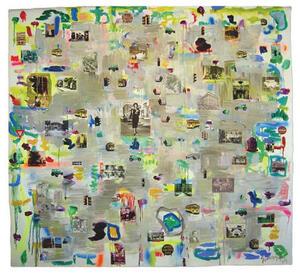Community: Remembering Baltimore's Neighborhoods
East Baltimore, where many of these women grew up, was the old heart of the city's Jewish community. Childhood memories evoke the sights and sounds of their neighborhoods and the sense of security people experienced on the city's steps and stoops. Despite growing prosperity, many Jews found housing options limited by restrictive covenants that kept Jews and African Americans out of certain neighborhoods. Perhaps this enforced containment of Baltimore's Jewish community is precisely what made it so dynamic and cohesive. Still, the Jewish community's steady migration north and west through the city reflected its climb up the economic ladder. They found homes in Druid Hill and Eutaw Place, Windsor Hills and Forest Park, Liberty Heights and Pikesville. But nothing seems to touch deep reservoirs of memory and feeling like "the old neighborhood."
The stories told by the women in this section of the exhibition were full of motion. They spoke of hustle and bustle, comings and goings, moving uptown and downtown, and from neighborhood to neighborhood. They were all aware of their spaces: what was around them, what it meant to them, where they could go, and where they could not go. They spoke of what it looked like, sounded like, smelled like, and felt like.
As the artist, I needed to capture this energy. I wanted to portray as many identifiable locations as possible and integrate them into my painting surface so that they would be recognizable. At the same time, the painting had to retain its artistic integrity. Streets, blocks, traffic, cars, streetcars, intersections, and specific locations were important elements of their lives.
This is a two-stage painting. There is a very colorful, noisy underpainting which represents the action and motion of these women's earlier times. The grey overpainting brings the viewer to the "now" which glimmers with flecks of the colorful past shown in the underpainting. I have created a visual border by allowing the underpainting to remain untouched along the periphery of the canvas. This represents the "other side," areas where most of the women whose oral histories I read did not go. Their world was defined by what went on within this border, contrasted by what happened "over there." Although this is a fl at painting, there is a recurring sense of dimension and perspective suggested throughout by the nature of the photographs. I was compelled to make soft pencil lines throughout the painting, extending the lines of perspective that the photographs suggested. It became apparent that just as there were different lines of perspectives within the painting, there were also different life perspectives among this group of women. Because there are multiple vanishing points in the painting, there can then be NO single point in which to vanish.
Ah, to not vanish! Is that not, indeed, the very purpose of this exhibition? And so, my soft pencil marks, suggesting lines to vanishing points, are simultaneously, lines of radiance. These memories, these women, and our People, will not vanish, but rather, they will radiate.



